
This Step is Performed on the Host Server Using
the Microsoft or Linux iSCSI Initiator
This Step is Performed on the Storage Array Using
PowerVault MD Storage Manager
8. (Optional) Set up in-band management
NOTE: It is recommended that you use the PowerVault Modular Disk Configuration Utility (MDCU)
for iSCSI configuration. The PowerVault MDCU wizards guides you through the configuration steps
described above. If you want to perform a manual configuration, see
Appendix — Manual
Configuration of iSCSI
.
Automatic Configuration Using The Modular Disk Configuration Utility
NOTE: If PowerVault MDCU is not installed, it can be installed from the PowerVault MD Series
resource media.
PowerVault MDCU provides a consolidated approach for configuring the iSCSI network of host servers
and iSCSI-based storage arrays using a wizard-driven interface. This utility also enables the user to
configure the iSCSI sessions of the host server according to the best practices and to achieve load-
balanced paths with the storage array iSCSI host ports. If you select
Launch the MDCU
after reboot
during the installation of the host software, the utility automatically launches after the next host server
reboot. This utility can also be launched manually.
The utility has a context sensitive online help to guide you through each step of the wizard.
The PowerVault MDCU performs:
• Storage array configuration
• Host configuration
Storage Array Configuration
Before a host iSCSI initiator and an iSCSI-based storage array can communicate, they must be configured
with information such as which IP addresses and authentication method to use. Since iSCSI initiators
establish connections with an already configured storage array, the first task is to configure your storage
arrays to make them available for iSCSI initiators.
This utility requires network access to the management ports of the storage arrays you wish to configure.
You must have a properly functioning network infrastructure before attempting to configure your storage
arrays. If your storage arrays are already configured, you can skip directly to the host configuration.
This configuration task generally involves the following steps:
1.
Discover available storage array(s) for configuration.
2.
Select a storage array to configure.
3.
Set a storage array name and password.
4.
Configure the IP protocols and addresses for the management ports.
5.
Configure the IP protocols and addresses for the iSCSI ports.
6.
Specify the CHAP authentication method.
7.
Apply the settings after reviewing the summary.
8.
Repeat the procedure starting from step 2 to configure additional arrays.
Host Configuration (Host Connectivity Configuration)
After you have completed configuring your iSCSI-based storage arrays, the next task is to run this utility
on all hosts that need to access the storage arrays. Depending on your network configuration, your host
26
















































